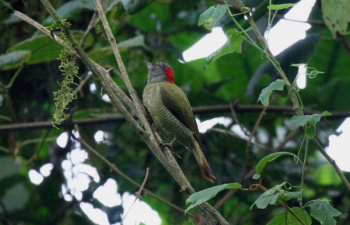- Campethera tullbergi
Identification

Photo © by megan perkins
Castle Forest Lodge, Mt Kenya, Kenya, 14 December 2006
18–20 cm (7-7¾ in)
Male
- Red cap variably mottled blackish on forecrown
- Face and throat grey with fine barring
- Olive-green above
- Underparts yellow-green barred with dark olive
Female
- Similar to male but crown black with small white spots
Immature
- Duller above
- More heavily barred below.
Similar Species
Buff-spotted Woodpecker is smaller with smaller bill, spotted chest and has red restricted to nape. Brown-eared Woodpecker is darker with rufous or brown ear patch and entirely spotted undeparts.
Distribution
Africa
Western Africa: found in Guinea, Nigeria, Cameroon, Equatorial Guinea, Democratic Republic of Congo
Eastern Africa: Kenya, Uganda, Rwanda, Uganda, Burundi, Tanzania
African Islands: Gulf of Guinea Islands: Bioko (Fernando Po)
Taxonomy
Some authors (e.g. HBW) split the barred subspecies under the name Fine-banded Woodpecker (C. taeniolaema)
Subspecies
There are 3 subspecies[1]:
- C. t. tullbergi: Spotted face and underparts; small red carpal spot
- C. t. taeniolaema: Face and underparts greenish with narrow barring
- C. t. hausburgi: As above but face and underparts yellowish
- Highlands of Kenya (east of Rift Valley) and extreme northern Tanzania
Habitat
Moist montane forest between 900 and 3000 m, generally using ravines and edges.
Behaviour
Diet
Their main diet consists of insects, particularly ants, caterpillars. They forage singly and in pairs, also joining mixed species flocks.
Breeding
They excavate a hole in a tree for the nest.
Vocalisations
Call not recorded. Usually silent. Reported to give a loud kweek-kweek-kweek
References
- Clements, J. F., T. S. Schulenberg, M. J. Iliff, D. Roberson, T. A. Fredericks, B. L. Sullivan, and C. L. Wood. 2018. The eBird/Clements checklist of birds of the world: v2018. Downloaded from http://www.birds.cornell.edu/clementschecklist/download/
- Avibase
- del Hoyo, J., Collar, N. & Christie, D.A. (2018). Fine-banded Woodpecker (Campethera taeniolaema). In: del Hoyo, J., Elliott, A., Sargatal, J., Christie, D.A. & de Juana, E. (eds.). Handbook of the Birds of the World Alive. Lynx Edicions, Barcelona. (retrieved from https://www.hbw.com/node/467467 on 30 December 2018).
- Winkler, H. & Christie, D.A. (2018). Tullberg's Woodpecker (Campethera tullbergi). In: del Hoyo, J., Elliott, A., Sargatal, J., Christie, D.A. & de Juana, E. (eds.). Handbook of the Birds of the World Alive. Lynx Edicions, Barcelona. (retrieved from https://www.hbw.com/node/56190 on 30 December 2018).
- Winkler, H., Christie, D.A. & Nurney, D. (1995) Woodpeckers: A guide to woodpeckers of the world. Houghton Mifflin.
- Stevenson, T., & Fanshawe, J. 2002. Birds of East Africa. Princeton Univ. Press
Recommended Citation
- BirdForum Opus contributors. (2024) Tullberg's Woodpecker. In: BirdForum, the forum for wild birds and birding. Retrieved 27 April 2024 from https://www.birdforum.net/opus/Tullberg%27s_Woodpecker




